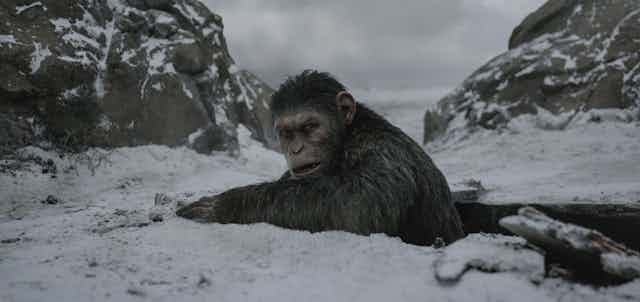All hail the Monkey King. Andy Serkis’s touching performance as Caesar in War for the Planet of the Apes has been critically acclaimed as heart-rending, emotionally harrowing and worthy of an Oscar.
Serkis continues to revolutionise screen performance using a motion captured avatar, conveying extraordinary emotional depth in the role. His success, often attributed to the mastery of animators and technicians, is testament to the rise of an entirely new approach to acting animals in an age of CGI, animation and motion capture.
Performance Capture (the total recording of a performance using a motion capture system) was first used in 2004. It is inherently theatrical, since a performance is filmed in its entirety - without multiple takes of a single scene. Actors wear suits with markers to help computers track their movements during the scene.
To perform as apes, Serkis and others are drawing on the techniques of method acting to emotionally connect with their simian characters. For Serkis, and Planet of the Apes movement choreographer and actor Terry Notary, this has meant going to extraordinary lengths to feel their way into their roles.
Serkis was led by Notary on all fours for hikes in the Canadian woods. They would spend two-hour stints not talking, only communicating as apes. The aim, says Notary, was to allow “the human conditioning to fall away”.
Further reading: Why motion capture performances deserve an Oscar
A brief history of monkey business on film
1968 was a big year for apes on film. Primates appeared in Stanley Kubrick’s 2001: A Space Odyssey and the original Planet of the Apes, starring Charlton Heston, first aired. In Space Odyssey, actors such as John Ashley donned monkey suits and set about charting the early history of tool use in the celebrated opening sequence known as The Dawn of Man.
In Planet of the Apes, actors such as Maurice Evans and Roddy McDowall relied on monkey masks with furry hands and feet to convey their simian characters. Their bodies were clothed in remarkably human-looking outfits.
Fully costumed performances of primates in films continued until 1995, when Misty Rosas as Amy the Gorilla in Congo performed alongside “enhanced gorillas” running through the jungle at an extraordinary pace, complete with appendages to extend their front limbs.
Over the last decade, we’ve seen a resurgence of cinematic apes, with a full reboot of the Planet of the Apes franchise, a couple of King Kongs, and more than one Tarzan. But the monkey suit has shifted from a furry outer layer to the modern motion capture suit as actors such as Ace Ruele in The Legend of Tarzan (2016) and Notary (alongside Serkis and others) in War for the Planet of the Apes (2017), Dawn of the Planet of the Apes (2014), and Rise of the Planet of the Apes (2011) transform how they perform - and we consume - monkeys on the screen.

Feeling like an Apeman (or woman)
With these new technologies, comes a revitalised interpretation of “The Method”. Primate actors are now exploring their performance by inhabiting and feeling “Ape”, and have developed their own “system” to perform as primates.
This system is built around the aspirations of Stanislavski - the father of method acting. It includes embodying the emotional state of the primate via practising regimented gait and walk cycles and using specific breathing techniques and even numbered approaches to gaze and smell. So, for instance, the scent of another primate in the distance would be given a number and a correlating pose, which ape actors would be instructed to adopt.
The Ape method includes a bespoke, non-verbal language used by actors to communicate with each other during filming. Aspiring actors can even take masterclasses with the likes of Notary, as seen in this video.
Serkis calls Notary (who also starred in Kong: Skull Island) “the greatest unsung hero of this entire [Planet of the Apes] franchise”.
Notary talks of “de-conditioning” to an play ape and finding each ape character’s “first position foundation” (a neutral non-human, pose). He says,
most of the actors that do play apes have told me that it’s been one of the most profound things they’ve done, because you have to be so honest with yourself.
He describes his own ape character, Rocket, as “that open, vulnerable, grounded, connected, feeling creature that I aspire to be all the time”.
As humans, our development of tools was made possible by our eventual rising to two feet, releasing our hands from the earth, Freed from holding objects (such as bones and babies) our hands and mouths could then perform other functions.
Our hands and minds now grasp vastly complicated objects, like virtual studios and motion capture systems, and use these to perfect the art of pretending to be monkeys. It’s a strange full circle – an origin story returning.

